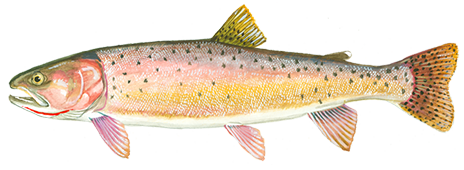Cutthroat Trout

Cutthroat trout are the most widely distributed of all the western trouts of North America.
HOW TO IDENTIFY A CUTTHROAT TROUT
This is a highly variable fish, in coloration and size. The characteristic that gave the cutthroat its name is the yellow, orange, or red streak in the skin fold on each side under the lower jaw. The color of the body ranges from cadmium blue and silvery (sea-run) to olive-green or yellowish green. There may or may not be red on the sides of the head, front part of the body, and the belly.
WHERE TO CATCH CUTTHROAT TROUT
They are known from the Eel River, California north to Prince William Sound, Alaska. Inland non-anadromous forms occur from southern Alberta, Canada to as far south as New Mexico, as far east as Colorado and most of Montana and west as far as Alberta and eastern California. A small, disjunct population which may have been transplanted to other locations, including the east coast of Quebec, Canada (1942), where it began to appear in anglers’ catches in 1966. The following list includes additional details on where to catch this fish:
OUTSIDES OF BENDS RIPARIAN ZONES
ROCK AND BOULDER POCKETS DROP-OFFS
MERGING CURRENTS STANDING WAVES
OVERHANGING TREES AND BUSHES CURRENT EDGES
RIVERS AND STREAMS DAMS AND FALLS
EDDIES SMALL POINTED WAVES
UNDERCUTS
HOW TO CATCH CUTTHROAT TROUT
The following are fishing methods used to catch this fish:
FLY FISHING STILL FISHING
BAIT CASTING SPIN CASTING
CUTTHROAT TROUT LURES, TACKLE & BAIT
The following are lures, tackle or bait that can be used to catch this fish:
CURED FISH ROE INSECTS
SPOONS FLIES
JIGS